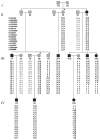Colorectal adenomas and cancer link to chromosome 13q22.1-13q31.3 in a large family with excess colorectal cancer
- PMID: 20522424
- PMCID: PMC3050714
- DOI: 10.1136/jmg.2009.076091
Colorectal adenomas and cancer link to chromosome 13q22.1-13q31.3 in a large family with excess colorectal cancer
Abstract
Background: Colorectal cancer is the fourth most common type of cancer and the second most common cause of cancer death. Fewer than 5% of colon cancers arise in the presence of a clear hereditary cancer condition; however, current estimates suggest that an additional 15-25% of colorectal cancers arise on the basis of unknown inherited factors.
Aim: To identify additional genetic factors responsible for colon cancer.
Methods: A large kindred with excess colorectal cancer was identified through the Utah Population Database and evaluated clinically and genetically for inherited susceptibility.
Results: A major genetic locus segregating with colonic polyps and cancer in this kindred was identified on chromosome 13q with a non-parametric linkage score of 24 (LOD score of 2.99 and p=0.001). The genetic region spans 21 Mbp and contains 27 RefSeq genes. Sequencing of all candidate genes in this region failed to identify a clearly deleterious mutation; however, polymorphisms segregating with the phenotype were identified. Chromosome 13q is commonly gained and overexpressed in colon cancers and correlates with metastasis, suggesting the presence of an important cancer progression gene. Evaluation of tumours from the kindred revealed a gain of 13q as well.
Conclusions: This identified region may contain a novel gene responsible for colon cancer progression in a significant proportion of sporadic cancers. Identification of the precise gene and causative genetic change in the kindred will be an important next step to understanding cancer progression and metastasis.
Conflict of interest statement
Disclosures: No potential conflicts of interest are disclosed.
Figures





References
-
- Lichtenstein P, Holm NV, Verkasalo PK, Iliadou A, Kaprio J, Koskenvuo M, et al. Environmental and heritable factors in the causation of cancer--analyses of cohorts of twins from Sweden, Denmark, and Finland. N Engl J Med. 2000;343(2):78–85. - PubMed
-
- Cannon-Albright LA, Skolnick MH, Bishop DT, Lee RG, Burt RW. Common inheritance of susceptibility to colonic adenomatous polyps and associated colorectal cancers. N Engl J Med. 1988;319(9):533–7. - PubMed
-
- Grady WM. Genetic testing for high-risk colon cancer patients. Gastroenterology. 2003;124(6):1574–94. - PubMed
-
- Burt R, Neklason DW. Genetic testing for inherited colon cancer. Gastroenterology. 2005;128(6):1696–716. - PubMed
-
- Fuchs CS, Giovannucci EL, Colditz GA, Hunter DJ, Speizer FE, Willett WC. A prospective study of family history and the risk of colorectal cancer. N Engl J Med. 1994;331(25):1669–74. - PubMed
Publication types
MeSH terms
Substances
Grants and funding
LinkOut - more resources
Full Text Sources
Medical
Miscellaneous
